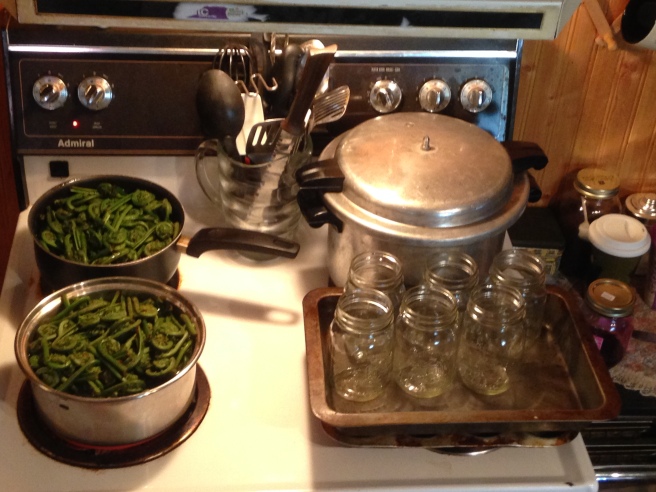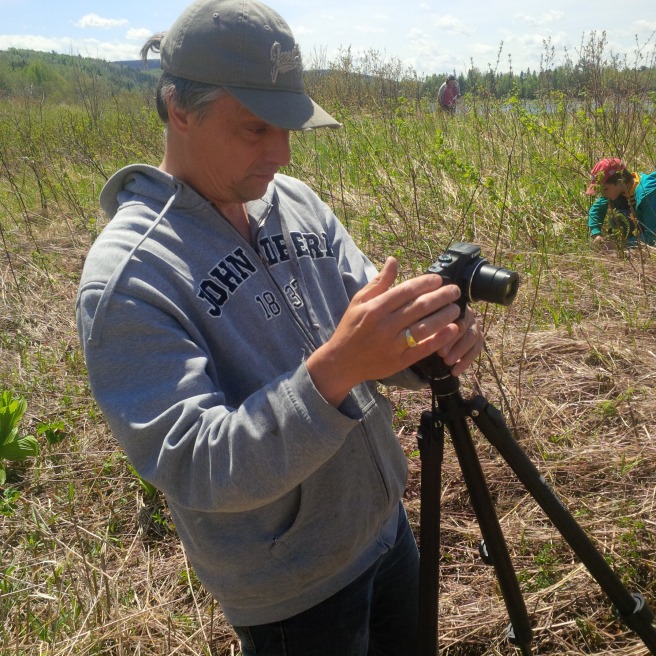
It all started with a very European type of dream: I would go to Canada later in my life (the mature and wise age of 50 sounded about right) and learn from First Nations people. La version en français suivra prochainement. Seules les photos et la vidéo sur YouTube existent en français.
Here we go. In 1999 I land in Canada but I am only 25. Oops – timing all mixed up, but never mind! I am here now, but I haven’t met very many people from First Nations communities apart from the few I worked with, or the people I interviewed when I was a news reporter in Prince Edward Island and Nova Scotia (usually these were sad stories), or during the few events I attended such as a Pow-Wow, a tea ceremony, and a Wigwam gathering .Turning 40, I decided I would go beyond organized events and ask to spend a day harvesting fiddleheads on one of the First Nations reserves that are in the province of New Brunswick, Canada.

I shared my dream with at least 10 friends, colleagues, and connections and finally it happened. I’ll never be able to express enough thanks to Jennifer Coleman and Cecelia Brooks who introduced me to Ursula Bear and her father Rocky Bear from Tobique First Nation, near Plaster Rock, NB.

Not only was one of my dreams coming true but I also shared this unforgettable experience with my loved ones, my son and my husband, who still talk about it regularly.
You should bring your son, said Ursula over the phone. It will be a great lesson for him to learn about our peoples’ tradition.
Oh, she was so right! When I ask him what he preferred about this day spent with Rocky & Ursula, my son always replies: “All of it!“

Check the French subtitles version of this video on YouTube. Cette vidéo a des sous-titres en français sur ma chaîne YouTube.
Click Here For Ursula’s Recipe
Rocky Bear is a proud member of Tobique First Nation, along the Tobique river. As a medicine gatherer, he told me so much about how plants are used to heal people all over North America aboriginal communities.

I also learned about the importance of eagle feathers you find on the ground, how you read them and interpret their meaning. And I heard very touching stories about how the land of the reserve, the landscape and the life of Tobique First Nation has been affected by decisions of the public administration over the past decades.

But today, I specifically want to share with you what I’ve learned about how to harvest and pickle fiddleheads as they do it on the Tobique First Nation Reserve. Tobique First Nation is one of the Wolastoqiyik or Maliseet Nation reserves in New Brunswick. The scenery is just beautiful.
Click Here For Ursula’s Recipe

- Tobique First Nation, New Brunswick (Canada). Première Nation Tobique, au Canada, dans la province du Nouveau-Brunswick.
1. What are fiddleheads ?
Fiddleheads are one of Eastern Canada’s most delicious plants to eat during the spring. Farmers markets & grocery stores get loads of them for 2 to 4 weeks in May or June every year. You can also buy them at roadside stands. When they are out, you have to eat them otherwise you’ll have to wait for next year unless you pickle them. Fiddleheads are not cultivated and are available only seasonally. They taste like asparagus — restaurants use them a lot while they’re in season. The fiddlehead resembles the curled ornamentation of a violin, which explains the name.

2. Why are fiddleheads so important for First Nations communities?Fiddleheads have been part of the Aboriginal traditional diet for ages.
Oh! It’s our staple. It’s our diet. We love fiddleheads here, says Rocky Bear.
First Nations communities have been eating them for centuries and still do. They are considered to be very healthy and ideal for cleansing your body during the spring season.

It’s a good cleansing for us in the spring time but it’s also good to eat health wise, it keeps us pretty healthy, Rocky says.
3. How do you pick them?
Fiddleheads usually grow in areas where it’s humid, along rivers or in the forest. They can’t be mixed with other type of ferns that can be toxic. This is why you have to learn how to pick them and when. There are 3 phases to the picking season.

What I call the first stage, or the early stage, it’s around May, says Rocky. This year I started picking on the Saturday before Mother’s Day (early May) and I wanted to get some fresh fiddleheads for Mother’s Day so I came out, which is a first for me because usually I like to wait until around the 2nd or the 3rd stage, and then I start picking like crazy. And it is fun.
The most important thing though is to make sure you pick them before the frond has opened and when they don’t show any black spots on the stem, which happens after a frost. These would not be good to eat.

4. How do you eat them?
When prepared properly, fiddleheads are a great seasonal addition to the dinner table, providing vitamin C, omega-3 and omega-6 fatty acids. One serving of fiddleheads (100 grams) contains around 34 calories and 4.6 grams of protein, some sources say.
Click Here For Ursula’s Recipe

The most tedious job is the cleaning. This is actually the difficult part of picking fiddleheads, says Ursula Bear. It’s important to remove as much of the brown husk as possible, manually. Then fiddleheads are washed using several changes of clean, cold water.

Fiddleheads usually get boiled or steamed for 15 minutes, until they are tender. Then the water is discarded. After this, the fiddleheads can be eaten as a side dish, a salad or they can be puréed, baked or pickled.

Fiddlehead pickling is Ursula Bear’s specialty. She is the owner and creator of The Bear Necessities Homemade Canned Goods and Crafts. She even sells her pickled fiddleheads in the capital city of New Brunswick as well as at different locations. Ursula blanches the fiddleheads for 5 minutes or more, dunks them in cold water, drains them and packs them in Mason jars where she adds vinegar.

You kinda try to pack them tightly because when you process them, when we put them back in the water to boil, they tend to shrink a little more. So I tend to pack them a little tight and then it does not seem like so much empty space in the jar, she says.
Once this part is done, she seals the jar and processes in a larger pot of boiling water for 10 minutes. And that’s the magic! All done. Ursula sells her products at diverse locations in New Brunswick. You can follow her work on Facebook.
So, on that same day, when I came home, I immediately started my own pickled fiddleheads following Ursula’s recipe. It was delicious, even though I should have waited for a longer period before opening the jars. I could not resist, and tasted them after a week. I really liked the texture and the taste. I will definitely pickle fiddleheads next year and have them ready for the cold and snowy season that can be so long in Canada. What a great idea: a taste of spring in the dead of winter!

Thanks again to Ursula Bear and Rocky Bear. I hope to see you again and learn more from you and your people. I also want to thank my sweetie, my husband who took photos and videos during our experience. If you like his photos, you’ll love his Instagram account.


Make sure to subscribe to my blog for more stories about wild edibles and healthy gluten free, vegetarian or vegan recipes.





Délicieuses petites crosses à goûter dès que possible !!
J’aimeAimé par 1 personne
C’est vrai, elles sont délicieuses et encore si croquantes!
J’aimeJ’aime
Cool!
J’aimeAimé par 1 personne
A reblogué ceci sur Angélique Binet.
J’aimeJ’aime